Sanatçının NASA’nın Europa Clipper uzay aracını görselleştirmesi. Kredi: NASA/JPL-Caltech
Europa Clipper uzay aracı, ABD’nin ana üretim tesisini işgal edecek.[{” attribute=””>NASA’s Jet Propulsion Laboratory (JPL) as it prepares for its 2024 launch to Jupiter’s icy moon Europa.
The core of NASA’s Europa Clipper spacecraft has taken center stage in the Spacecraft Assembly Facility at JPL in Southern California. Standing 10 feet (3 meters) high and 5 feet (1.5 meters) wide, the craft’s main body will be the focus of attention in the facility’s ultra-hygienic High Bay 1 for the next two years as engineers and technicians assemble the spacecraft. It’s scheduled for launch to Jupiter’s moon Europa in October 2024.

Standing 10 feet (3 meters) high, the core of NASA’s Europa Clipper will be the focus of attention in High Bay 1 of JPL’s storied Spacecraft Assembly Facility, as engineers and technicians assemble the spacecraft for a 2024 launch. Credit: NASA/JPL-Caltech
Scientists believe the ice-enveloped moon harbors a vast internal ocean that may harbor conditions suitable for supporting life. During nearly 50 flybys of Europa, the spacecraft’s suite of science instruments will gather data on the moon’s atmosphere, surface, and interior. Scientists will use that information to gauge the depth and salinity of the ocean, the thickness of the ice crust, and potential plumes that may be venting subsurface water into space.

Engineers and technicians use a crane to lift the core of NASA’s Europa Clipper spacecraft in the High Bay 1 clean room of JPL’s Spacecraft Assembly Facility. Credit: NASA/JPL-Caltech
Several of Europa Clipper’s science instruments have already been completed and will be installed on the spacecraft at JPL. Most recently, the plasma-detection instrument, called the Plasma Instrument for Magnetic Sounding, and the Europa Imaging System wide-angle camera arrived from the Johns Hopkins Applied Physics Laboratory (APL), in Laurel, Maryland. Additionally, the thermal-emission imaging instrument, called E-THEMIS, and the ultraviolet spectrograph, Europa-UVS, have already been installed on the spacecraft’s nadir deck, which will support many of the instrument sensors by stabilizing them to ensure they are oriented correctly.

Engineers and technicians use a crane to position the core of NASA’s Europa Clipper spacecraft during a maneuver to position it in the High Bay 1 clean room of JPL’s Spacecraft Assembly Facility. Credit: NASA/JPL-Caltech
Fabricated at JPL, this key piece of hardware will soon move into the Spacecraft Assembly Facility’s High Bay 1. This is the same clean room where historic missions such as Galileo, Cassini, and all of NASA’s Mars rovers were built.
Also moving soon to High Bay 1 will be the aluminum electronics vault, which will be bolted to the main body of the spacecraft. It will protect the electronics inside from Jupiter’s intense radiation. The electronics enable Europa Clipper’s computer to communicate with the spacecraft’s antennae, science instruments, and the subsystems that will keep them alive.

Europa Clipper’s vault, with the nadir deck attached, is prepared for a move to the High Bay 1 clean room of the Spacecraft Assembly Facility at JPL. The vault will protect the spacecraft’s electronics, while the nadir deck will provide a stable platform for science instruments. Credit: NASA/JPL-Caltech
Bright copper cabling snakes around the orbiter’s aluminum core. It contains thousands of wires and connectors handcrafted at APL. If placed end to end, the cabling would stretch almost 2,100 feet (640 meters) – enough to wrap around a U.S. football field twice.
Inside the core are Europa Clipper’s two propulsion tanks. The fuel and oxidizer they’ll hold will flow to an array of 24 engines, where they will create a controlled chemical reaction to produce thrust in deep space.
Bu hızlandırılmış video, NASA’nın Europa Clipper uzay aracının, JPL’deki Uzay Aracı Montaj Tesisi High Bay 1 temiz odasına dikkatlice koreografisi yapılmış hareketini takip ediyor. Kredi: NASA/JPL-Caltech
2022’nin sonunda, uçuş donanımının çoğunun ve bilim araçlarının geri kalanının tamamlanması bekleniyor. Ardından, uzay aracı 2024 fırlatma dönemine doğru ilerlerken, sonraki adımlar çok çeşitli testler olacak. Yaklaşık altı yıl ve 1,8 milyar mil (2,9 milyar kilometre) üzerinde seyahat ettikten sonra, 2030’da Jüpiter’in yörüngesine ulaşacak.
Misyon Hakkında Daha Fazla Bilgi
Europa Clipper gibi görevler astrobiyoloji alanına katkı sağlıyor. Bildiğimiz şekliyle yaşamı barındırabilecek uzak dünyaların koşullarını inceleyen bu disiplinler arası araştırma alanı. Europa Clipper bir yaşam tespit görevi olmasa da, Europa’nın ayrıntılı bir araştırmasını yürütecek ve yeraltı okyanusuyla buzlu uydunun yaşamı destekleyip desteklemediğini araştıracak. Europa’nın yaşanabilirliğini anlamak, araştırmacıların Dünya’da yaşamın nasıl geliştiğini ve gezegenimizin ötesinde yaşam bulma potansiyelini daha iyi anlamalarına yardımcı olacaktır.
California, Pasadena’daki California Institute of Technology (Caltech) tarafından yönetilen JPL, NASA’nın Washington’daki Bilim Misyonu Müdürlüğü için APL ile ortaklaşa Europa Clipper misyonunun geliştirilmesine öncülük ediyor. APL, ana uzay aracı gövdesini JPL ve NASA’nın Greenbelt, Maryland’deki Goddard Uzay Uçuş Merkezi ile işbirliği içinde tasarladı. NASA’nın Alabama, Huntsville’deki Marshall Uzay Uçuş Merkezi’ndeki Gezegensel Görevler Program Ofisi, Europa Clipper görevinin program yönetimini yürütüyor.

